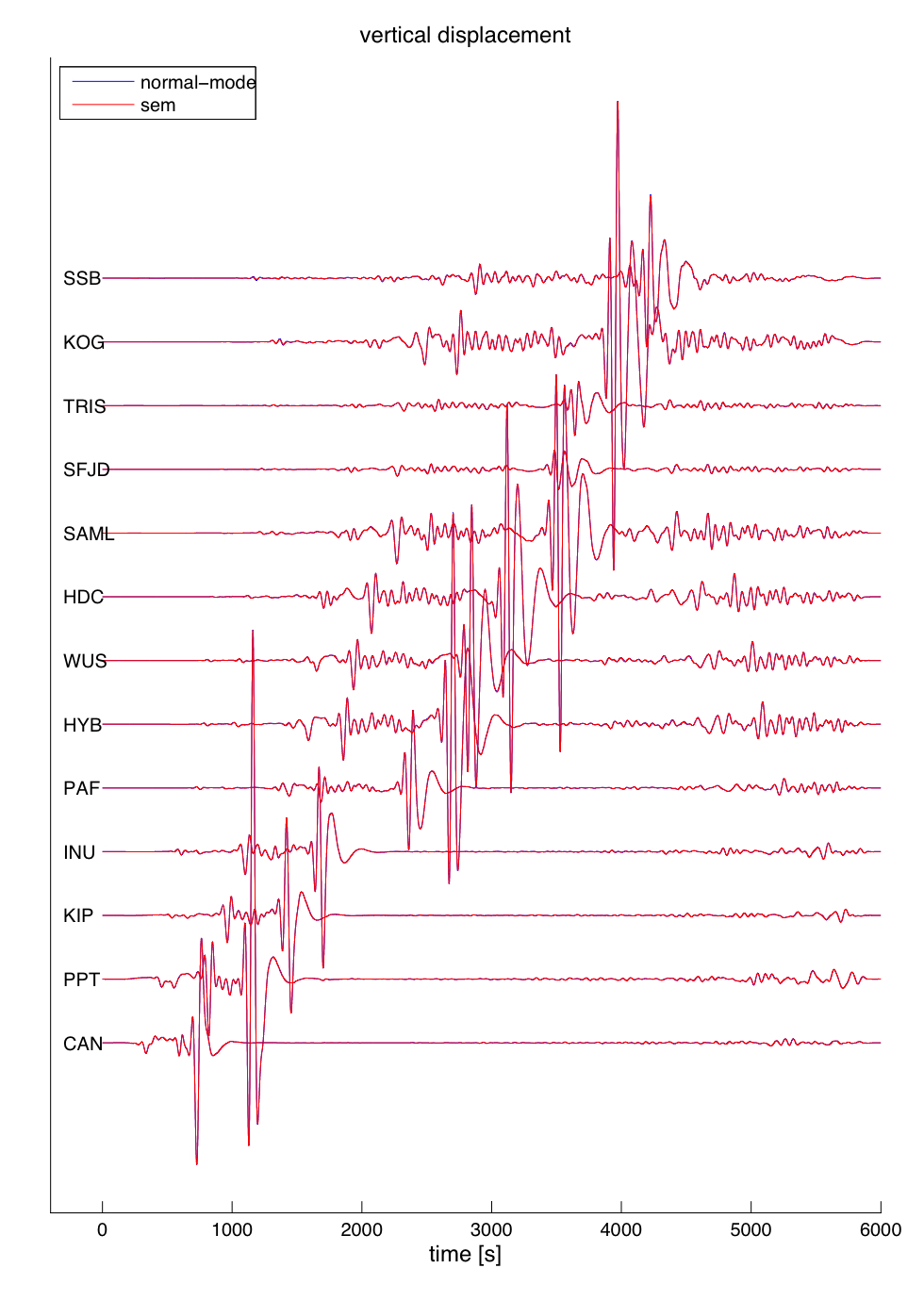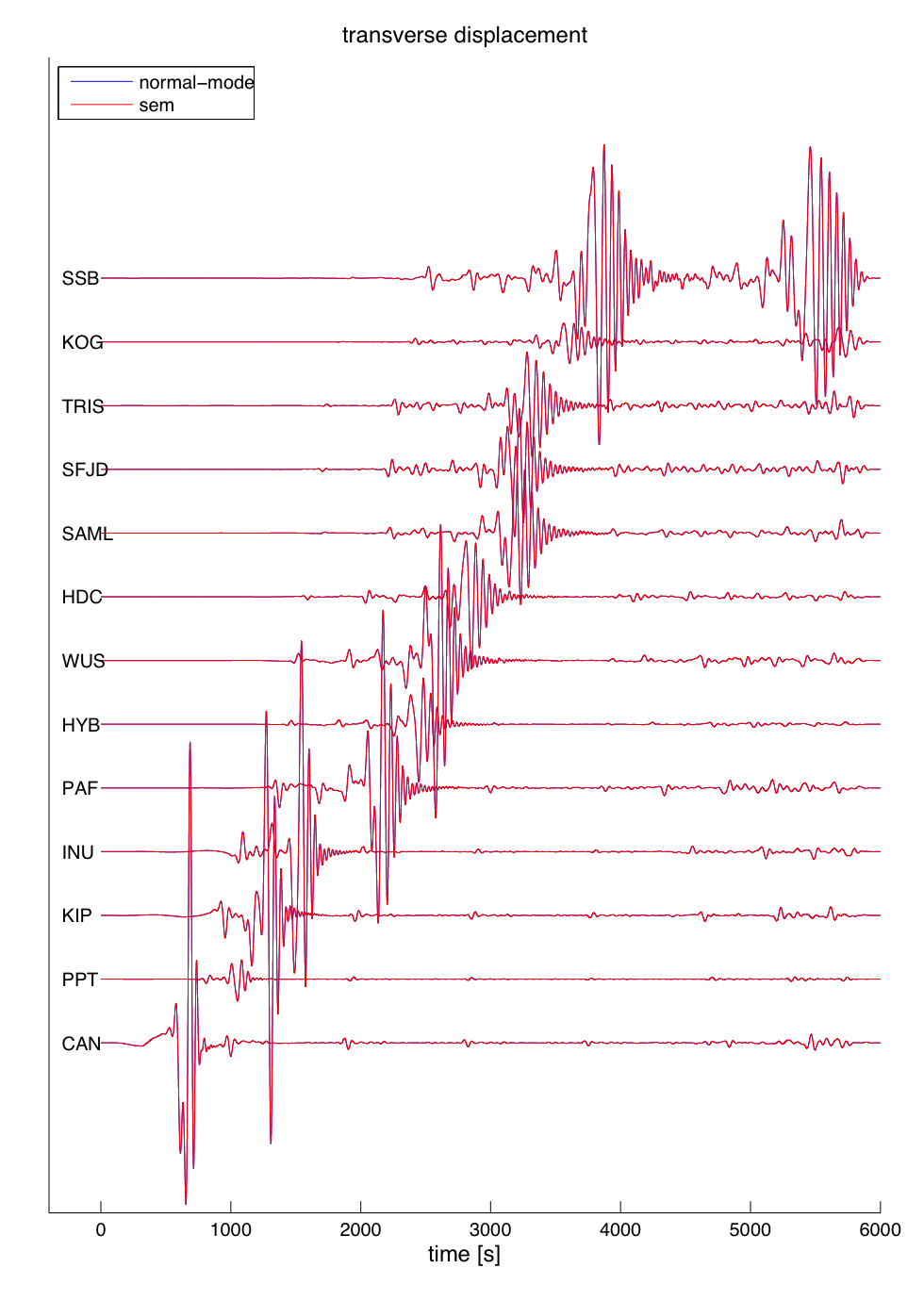Long-period benchmark
We present here a ‘long-period’ (periods longer than 17 s) simulation of a shallow event in isotropic PREM (Dziewonski and Anderson, 1981]}without the ocean layer, without attenuation but including the effects of self-gravitation (in the Cowling approximation) (Figures C.1 and C.2).
Normal-mode synthetics
The normal-mode synthetics are calculated with the code QmXD using mode catalogs with a shortest period of 8 s generated by the code OBANI. No free-air, tilt, or gravitational potential corrections were applied (Dahlen and Tromp, 1998}. We also turned off the effect of the oceans in QmXD.
Results
The normal-mode and SEM displacement seismograms are first calculated for a step source-time function, i.e., setting the parameter half duration in the CMTSOLUTION file to zero for the SEM simulations. Both sets of seismograms are subsequently convolved with a triangular source-time function using the processing script UTILS/seis_process/process_syn.pl.
They are also band-pass filtered and the horizontal components are rotated to the radial and transverse directions (with the script UTILS/seis_process/rotate.pl). The match between the normal-mode and SEM seismograms is quite remarkable for the experiment with attenuation, considering the very different implementations of attenuation in the two computations (e.g., frequency domain versus time domain, constant Q versus absorption bands).
You can download this benchmark example: benchmark_examples.tar.gz (95 MB, uploaded by Lorraine Hwang 2 years 8 months ago) (~96 MB).
- To unzip the tar ball file, type
tar -zxvf benchmark_examples.tar.gz
Further tests can be found in the EXAMPLES directory. It contains the normal-mode and SEM seismograms, and the parameters (STATIONS, CMTSOLUTION and Par_file) for the SEM simulations.
Figure C.1 (vanuatu_vertical.pdf (356 KB, uploaded by Lorraine Hwang 2 years 8 months ago)): Normal-mode (blue) and SEM (red) vertical displacements in isotropic PREM considering the effects of self-gravitation but not attenuation for 13 stations at increasing distance from the 1999 November 26th Vanuatu event located at 15 km depth. The SEM computation is accurate for periods longer than 17~s. The seismograms have been filtered between 50~s and 500~s. The station names are indicated on the left.
Figure C.2 (vanuatu_trans.pdf (309 KB, uploaded by Lorraine Hwang 2 years 8 months ago)): Same as in Figure C.1 for the transverse displacements
Important remark:
When comparing SEM results to normal mode results, one needs to convert source and receiver coordinates from geographic to geocentric coordinates, because on the equator the geographic and geocentric latitude are identical but not elsewhere. Even for spherically-symmetric simulations one must perform this conversion because the source and receiver locations provided by globalCMT.org and IRIS involve geographic coordinates.
References
F. A. Dahlen and J. Tromp. Theoretical Global Seismology. Princeton University Press, Princeton, New-Jersey, USA, 1998.
A. M. Dziewonski and D. L. Anderson. Preliminary reference Earth model. Phys. Earth Planet. In., 25:297-356, 1981.
D. Komatitsch and J. Tromp. Spectral-element simulations of global seismic wave propagation-I. Validation. Geophys. J. Int., 149 (2):390–412, 2002a. doi: 10.1046/j.1365- 246X.2002.01653.x.
D. Komatitsch and J. Tromp. Spectral-element simulations of global seismic wave propagation-II. 3-D models,oceans,rotation,and self-gravitation. Geophys. J. Int., 150(1):303–318, 2002b. doi: 10.1046/j.1365-246X.2002.01716.x.



